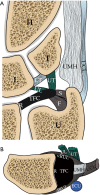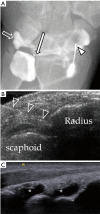MR imaging of the traumatic triangular fibrocartilaginous complex tear
- PMID: 28932701
- PMCID: PMC5594018
- DOI: 10.21037/qims.2017.07.01
MR imaging of the traumatic triangular fibrocartilaginous complex tear
Abstract
Triangular fibrocartilage complex is a major stabilizer of the distal radioulnar joint (DRUJ). However, triangular fibrocartilage complex (TFCC) tear is difficult to be diagnosed on MRI for its intrinsic small and thin structure with complex anatomy. The purpose of this article is to review the anatomy of TFCC, state of art MRI imaging technique, normal appearance and features of tear on MRI according to the Palmar's classification. Atypical tear and limitations of MRI in diagnosis of TFCC tear are also discussed.
Keywords: MRI; arthrogram; tear; the triangular fibrocartilage complex (TFCC); wrist.
Conflict of interest statement
Conflicts of Interest: The authors have no conflicts of interest to declare.
Figures




















References
Publication types
LinkOut - more resources
Full Text Sources
Other Literature Sources
